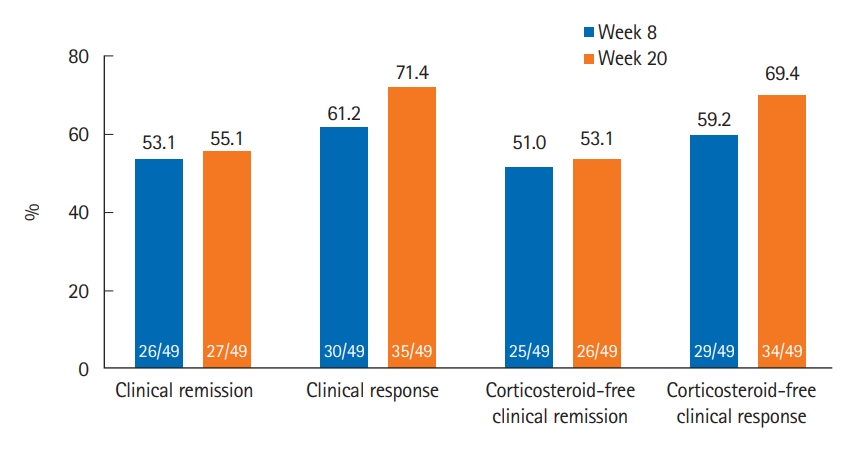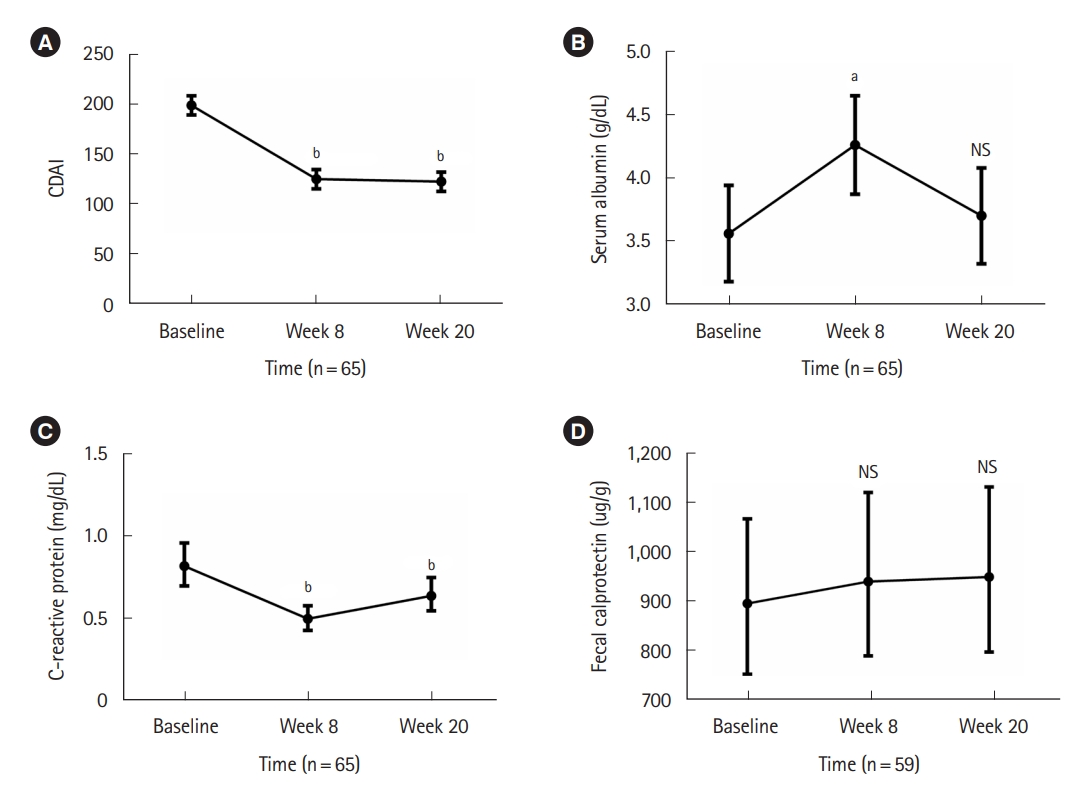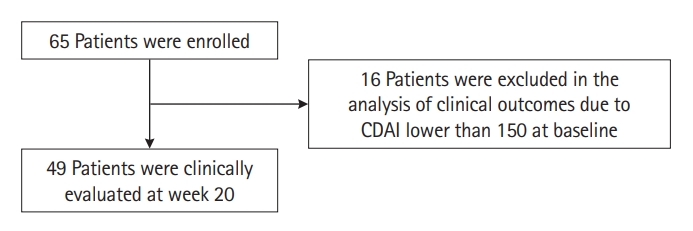 |
 |
- Search
| Intest Res > Volume 21(1); 2023 > Article |
|
Abstract
Background/Aims
Methods
Results
ADDITIONAL INFORMATION
Funding Source
This work was supported by the National Research Foundation of Korea (NRF) grant funded by the Korean government (MSIT) (NRF-2021R1A2C2095096).
Conflict of Interest
Ye BD has received a research grant from Celltrion and Pfizer Korea; consulting fees from Abbvie Korea, Celltrion, Chong Kun Dang Pharm., CJ Red BIO, Daewoong Pharma., Ferring Korea, Janssen Korea, Kangstem Biotech, Medtronic Korea, Pfizer Korea, Shire Korea, Takeda Korea, IQVIA, Cornerstones Health, and Takeda; speaking fees from Abbvie Korea, Celltrion, Ferring Korea, Janssen Korea, Pfizer Korea, Shire Korea, Takeda Korea, and IQVIA. Yang SK has received a research grant from Janssen Korea. None of the above-mentioned grants are related to this study. Other authors have nothing to declare.
Kim YS is an editorial board member of the journal but was not involved in the peer reviewer selection, evaluation, or decision process of this article. No other potential conflicts of interest relevant to this article were reported.
Author Contribution
Conceptualization: Ye BD. Project administration: Ye BD. Data collection: Oh K, Hong HS, Ham NS, Park SH, Yang SK, Yoon H, Kim YS, Choi CH, Ye BD. Analysis and interpretation of the data: Oh K, Hong HS, Lee J, Ye BD. Writing - original draft: Oh K, Hong HS. Writing - review and editing: Ye BD. Approval of the final manuscript: Oh K, Hong HS, Ham NS, Lee J, Park SH, Yang SK, Yoon H, Kim YS, Choi CH, Ye BD. Approval of final manuscript: all authors.
Fig. 2.

Fig. 3.

Table 1.
| Variable | Value (n = 65) |
|---|---|
| Age (yr) | 33.0 (27.0-45.0) |
| Male sex | 48 (73.8) |
| Disease duration from diagnosis to ustekinumab commencement (mo) | 114.0 (85.0-177.0) |
| First-degree family history of inflammatory bowel disease | 2 (3.1) |
| Smoking status | |
| Never | 46 (70.8) |
| Past smoker | 12 (18.5) |
| Current | 6 (9.2) |
| Unknown | 1 (1.5) |
| Body mass index (kg/m2) | 20.1 (18.3-24.5) |
| Disease location | |
| Ileum (L1) | 13 (20.0) |
| Colon (L2) | 2 (3.1) |
| Ileocolon (L3) | 50 (76.9) |
| Upper gastrointestinal involvement | 13 (20.0) |
| Disease behavior | |
| Nonstricturing, nonpenetrating (B1) | 14 (21.5) |
| Stricturing (B2) | 26 (40.0) |
| Penetrating (B3) | 25 (38.5) |
| Perianal disease modifier | 32 (49.2) |
| History of bowel resection surgery | 36 (55.4) |
| Surgical history for perianal abscess/fistula | 36 (55.4) |
| Concomitant immunomodulators | 40 (61.5) |
| Concomitant systemic corticosteroids | 5 (7.7) |
| Prior use of biologics | |
| Biologic-naïve | 7 (10.8) |
| Anti-TNFs onlya | 37 (56.9) |
| Anti-TNFs+vedolizumabb | 21 (32.3) |
| CDAI | 209.8 (128.8-240.9) |
| Clinical disease activity | |
| Remission (CDAI < 150) | 16 (24.6) |
| Mild (150 ≤ CDAI < 220) | 13 (20.0) |
| Moderate (220 ≤ CDAI < 450) | 36 (55.4) |
| Severe (CDAI ≥ 450) | 0 |
| White blood cell (/μL) | 6,280 (4,599-8,400) |
| Hemoglobin (g/dL) | 12.4 (11.3-13.5) |
| Serum albumin (g/dL) | 3.5 (3.2-3.8) |
| Serum C-reactive protein (mg/dL) | 0.91 (0.45-1.88) |
| Fecal calprotectin (mg/kg) | 1,304 (394-2,011) |
a Infliximab (including infliximab biosimilar) for 22 patients, adalimumab for 3 patients, and infliximab (including infliximab biosimilar)+adalimumab for 12 patients.
Table 2.
| Variable |
Univariable |
Multivariable |
||
|---|---|---|---|---|
| OR (95% CI) | P-value | OR (95% CI) | P-value | |
| Age (per 1 yr) | 1.036 (0.988-1.086) | 0.145 | ||
| Female sex | 1.123 (0.322-3.919) | 0.856 | ||
| Disease duration (per 1 mo) | 0.993 (0.984-1.002) | 0.144 | ||
| Smoking status | 0.984 | |||
| Never smoker | Reference | |||
| Past smoker | 0.987 (0.225-4.330) | 0.986 | ||
| Current smoker | 1.184 (0.175-8.021) | 0.862 | ||
| Body mass index | ||||
| < 18.5 kg/m2 | 0.104 (0.024-0.451) | 0.002a | 0.085 (0.014-0.498) | 0.006 |
| ≥ 18.5 kg/m2 | Reference | |||
| Disease location | 0.178 | |||
| Ileum (L1) | Reference | |||
| Colon (L2) | 999.999 (0.000-999.999) | > 0.999 | ||
| Ileocolon (L3) | 0.253 (0.059-1.078) | 0.063 | ||
| Upper GI involvement | 0.373 (0.093-1.496) | 0.164 | ||
| Disease behavior | 0.088a | |||
| Nonstricturing, nonpenetrating (B1) | Reference | |||
| Stricturing (B2) | 3.333 (0.663-16.764) | 0.144 | ||
| Penetrating (B3) | 0.795 (0.157-4.022) | 0.782 | ||
| Perianal disease modifier | 0.188 (0.055-0.643) | 0.008a | 0.239 (0.053-1.081) | 0.053 |
| Previous use of biologic agents | 0.000 (0.000-999.999) | 0.999 | ||
| Concomitant immunomodulators | 0.615 (0.195-1.945) | 0.408 | ||
| Concomitant systemic corticosteroids | 0.244 (0.023-2.527) | 0.237 | ||
| History of bowel resection surgery | 0.317 (0.091-1.106) | 0.072a | ||
| History of perianal abscess/fistula surgery | 0.275 (0.081-0.930) | 0.038a | ||
| CDAI at baseline | ||||
| < 220 | Reference | |||
| ≥ 220 | 2.514 (0.683-9.252) | 0.165 | ||
| Serum albumin at baseline (per 1 g/dL) | 8.829 (1.883-41.391) | 0.006a | ||
| Elevated CRP (≥ 0.6 mg/dL) at baseline | 0.222 (0.059-0.839) | 0.026a | 0.133 (0.022-0.823) | 0.030 |
Table 3.
| Variable |
Univariable |
Multivariable |
||
|---|---|---|---|---|
| OR (95% CI) | P-value | OR (95% CI) | P-value | |
| Age (per 1 yr) | 1.047 (0.987-1.109) | 0.125 | ||
| Female | 3.130 (0.600-16.327) | 0.176 | ||
| Disease duration (per 1 mo) | 0.996 (0.986-1.005) | 0.395 | ||
| Smoking status | 0.523 | |||
| Never smoker | Reference | |||
| Past smoker | 0.450 (0.098-2.057) | 0.303 | ||
| Current smoker | 1.440 (0.142-14.653) | 0.758 | ||
| Body mass index | ||||
| < 18.5 kg/m2 | 0.462 (0.126-1.697) | 0.244 | ||
| ≥ 18.5 kg/m2 | Reference | |||
| Disease location | > 0.999 | |||
| Ileum (L1) | Reference | |||
| Colon (L2) | 999.999 (0.000-999.999) | > 0.999 | ||
| Ileocolon (L3) | < 0.001 (0.000-999.999) | 0.999 | ||
| Upper GI involvement | 0.625 (0.150-2.599) | 0.518 | ||
| Disease behavior | 0.049a | |||
| Nonstricturing, nonpenetrating (B1) | Reference | |||
| Stricturing (B2) | 1.810 (0.248-13.211) | 0.559 | ||
| Penetrating (B3) | 0.286 (0.046-1.769) | 0.178 | ||
| Perianal disease modifier | 0.182 (0.043-0.771) | 0.021a | ||
| Previous use of biologic agents | 0.000 (0.000-999.999) | 0.999 | ||
| Concomitant immunomodulators | 0.424 (0.111-1.610) | 0.207 | ||
| Concomitant systemic corticosteroids | 0.108 (0.010-1.146) | 0.065a | ||
| History of bowel resection surgery | 0.198 (0.038-1.018) | 0.053a | 0.123 (0.019-0.801) | 0.028 |
| History of perianal abscess/fistula surgery | 0.242 (0.057-1.027) | 0.054a | ||
| CDAI at baseline | ||||
| < 220 | Reference | 5.124 (0.979-26.836) | 0.053 | |
| ≥ 220 | 8.000 (1.933-33.101) | 0.004a | ||
| Serum albumin at baseline (per 1 g/dL) | 2.937 (0.817-10.563) | 0.099a | ||
| Elevated CRP (≥ 0.6 mg/dL) at baseline | 0.211 (0.041-1.091) | 0.064a | 0.212 (0.033-1.380) | 0.105 |









